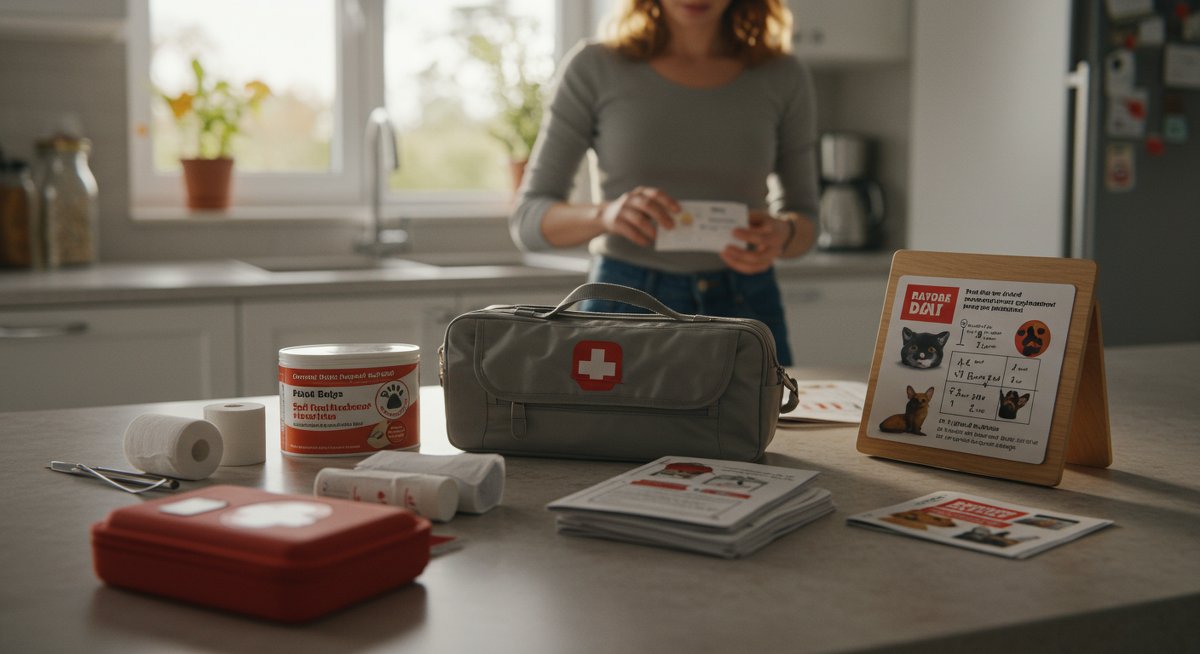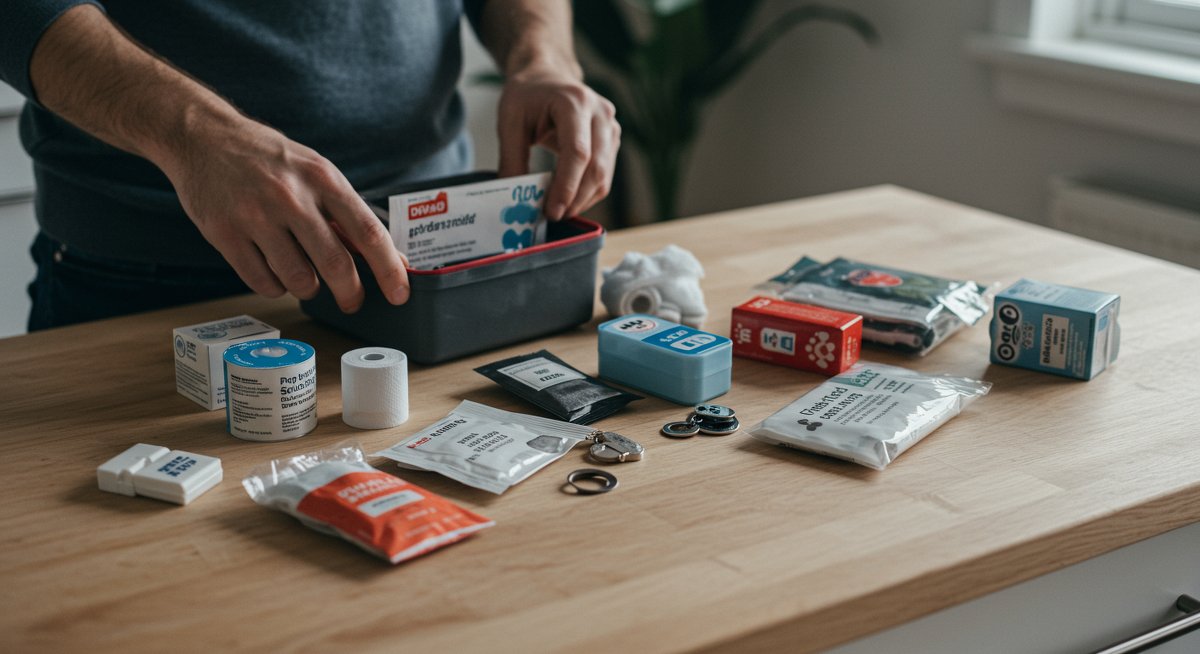Bringing a new pet home is a joyous occasion, but it also comes with responsibilities, including being prepared for unexpected emergencies. Accidents and illnesses can happen, and having a well-stocked pet first aid kit can make a significant difference in your pet's health and well-being. This guide provides new pet owners with a comprehensive checklist of essential items, tips for usage, and advice on when to seek professional veterinary care. Being prepared can alleviate stress and provide immediate care before a vet visit.

Why a Pet First Aid Kit is Crucial for Your New Pet
As a new pet owner, you're likely eager to create a safe and loving environment for your furry friend. However, it's essential to understand that pets, like humans, can experience injuries and illnesses. A pet first aid kit allows you to provide immediate care for minor issues and stabilize your pet before you can get to a veterinarian. This preparedness can significantly improve outcomes in emergencies, reduce your pet's suffering, and give you peace of mind.
For example, imagine your dog cuts his paw while playing in the park. Having antiseptic wipes and bandages on hand allows you to clean the wound and protect it from infection until you can get to the vet. Without these supplies, the cut could worsen, leading to infection or more serious complications. Similarly, if your cat experiences a minor allergic reaction, having antihistamines (as directed by your vet) can provide immediate relief.
Essential First Steps for [Pet Type] Care
When you first get your pet, setting up a basic first aid kit should be a priority. Here's a step-by-step guide to get you started:
- Choose a container: Select a waterproof, easy-to-carry container, such as a plastic toolbox or a sturdy bag. Label it clearly as a “Pet First Aid Kit.”
- Gather supplies: Use the checklist below to gather the essential items. Consider creating a physical checklist to keep track of expiration dates and restock items as needed.
- Store in an accessible location: Keep your kit in an easily accessible location at home and in your car, especially if you travel with your pet.
- Learn basic first aid: Consider taking a pet first aid and CPR course. This will give you confidence in administering care. Many veterinary clinics and organizations offer these courses.
- Know your vet's information: Keep your veterinarian's phone number, as well as the number of the nearest emergency veterinary clinic, readily available in your kit.
Example: Sarah, a new dog owner, quickly assembled a first aid kit after adopting her puppy, Max. She included bandages, antiseptic wipes, and a digital thermometer. Within a week, Max cut his paw. Sarah was able to clean and bandage the wound, preventing infection until she could visit the vet. The vet praised her for her quick action.
Example: John, a cat owner, adopted a senior cat named Whiskers. Understanding the need for preparedness, John created a first aid kit with medications prescribed by his vet for pre-existing health conditions and emergency items. When Whiskers experienced a sudden bout of vomiting, John could provide initial care and transport him to the vet, leading to a swift diagnosis and treatment.
Example: A family with a playful Labrador named Buddy prepared a car kit for traveling. While on a camping trip, Buddy got a minor injury. Because of the preparedness, the family cleaned, dressed, and monitored the injury, thus reducing any complications.
Common Challenges & How to Overcome Them
One of the most common challenges is knowing what to include and what to do with each item. Many new pet owners are unsure about administering first aid, but with practice and the right resources, you can become more confident. Another challenge is keeping the kit up to date. Supplies can expire, and some items may need replacing.
Here's how to address these challenges:
- Create a checklist: Use the detailed checklist below to ensure you have all the necessary items.
- Read instructions: Before an emergency, read the instructions on how to use each item.
- Attend a training course: Taking a pet first aid and CPR course can significantly boost your confidence and skills.
- Regularly check expiration dates: Replace expired medications and supplies to ensure they are effective.
- Consult your vet: Ask your veterinarian for advice on specific items and dosages for your pet.
Tips for Success (e.g., basic training, feeding schedules)
- Bandaging: Learn how to properly apply a bandage. Make sure it's not too tight, as this can restrict blood flow. Check the bandage daily and replace it if it becomes wet or soiled.
- Medication administration: Ask your vet to demonstrate how to give oral medications, eye drops, or ear medications.
- Recognizing emergencies: Learn to recognize the signs of a pet emergency, such as difficulty breathing, severe bleeding, or loss of consciousness.
- Emergency contact information: Have your vet's phone number, the number for the nearest emergency vet clinic, and the ASPCA Animal Poison Control Center readily available. (1-888-426-4435)
- Practice makes perfect: Practice taking your pet’s temperature and examining their mouth or paws when they are calm.
Recommended Products for New Owners
Here's a detailed list of essential items for your pet first aid kit, along with explanations of their uses:
- Antiseptic Wipes: ([referral_url]"" for a generic product or specific brand like a Pet-Friendly Antiseptic Wipe) These are crucial for cleaning minor wounds and cuts. Choose alcohol-free wipes to avoid stinging your pet.
- Bandage Materials: Include self-adhesive bandages, sterile gauze pads, and medical tape. These are for covering and protecting wounds.
- Digital Thermometer: Use a rectal thermometer to measure your pet's temperature. Normal temperature for dogs and cats is between 100.5°F and 102.5°F (38.3°C and 39.2°C).
- Eye Wash Solution: ([referral_url]"" for a generic product or specific brand) Used to flush out irritants or debris from your pet's eyes.
- Saline Solution: ([referral_url]"" for a generic product or specific brand) For flushing wounds.
- Hydrogen Peroxide (3%): ([referral_url]"" for a generic product or specific brand) Use cautiously to induce vomiting if your vet advises it in case of poisoning. Only use it as directed by your vet.
- Tweezers: For removing splinters or ticks.
- Nylon Leash and Muzzle: ([referral_url]"" for a generic product or specific brand) A leash can help secure a scared or injured pet. A muzzle can prevent biting if your pet is in pain.
- Pet Carrier: ([referral_url]"" for a generic product or specific brand) To transport your injured pet safely to the vet.
- Gloves: To protect yourself from potential infections.
- Scissors: To cut bandages or fur.
- Syringe or Dropper: To administer oral medications or flush wounds.
- Cotton Balls and Swabs: To apply antiseptics or clean wounds.
- Emergency Contact Information: Your veterinarian's number, the nearest emergency vet clinic, and the ASPCA Animal Poison Control Center.
- Current Medication Information: List of any medications your pet is currently taking.
- Pet First Aid Guide: A small, portable guide to help you with basic first aid procedures.

Quick Troubleshooting Guide
Here's a quick guide to handle common pet emergencies:
- Bleeding: Apply direct pressure to the wound with a clean cloth or bandage. If the bleeding doesn't stop within 5-10 minutes, seek immediate veterinary attention.
- Choking: If your pet is choking, carefully open the mouth and look for the obstruction. If you can see it, try to remove it. If not, seek immediate veterinary help.
- Poisoning: If you suspect poisoning, try to identify the substance and contact your veterinarian or the ASPCA Animal Poison Control Center immediately. Do not induce vomiting unless advised by your vet.
- Heatstroke: Move your pet to a cool, shaded area. Apply cool water to their body, especially the paws and abdomen. Seek veterinary care immediately.
- Seizures: Protect your pet from injury and keep them away from hazards. Do not put your hands near their mouth. Seek veterinary care immediately after the seizure.
Next Steps in Your Pet Parenthood Journey
Creating a pet first aid kit is just one step in being a responsible pet owner. Here are some next steps to take:
- Schedule a check-up: Schedule a comprehensive check-up with your veterinarian. They can provide valuable advice and ensure your pet is in good health.
- Consider pet insurance: Pet insurance can help cover unexpected veterinary costs. Research different insurance options and choose a plan that suits your needs.
- Take a pet first aid and CPR course: Increase your confidence and skills by taking a course.
- Update your kit regularly: Check expiration dates and replace items as needed.
- Stay informed: Continue to research pet care best practices and stay up-to-date on the latest recommendations from your veterinarian.
Being prepared for pet emergencies can make a significant difference in your pet's health and well-being. With a well-stocked first aid kit and a basic understanding of first aid techniques, you can provide immediate care and increase your pet's chances of a full recovery. Remember that a pet first aid kit is not a replacement for professional veterinary care, but it can provide critical support until you can seek professional help.